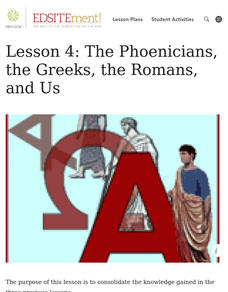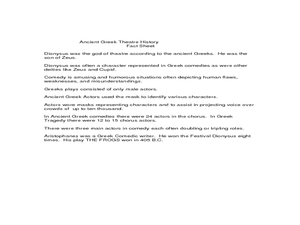National Endowment for the Humanities
Lesson 4: The Phoenicians, the Greeks, the Romans, and Us
Learners review knowledge gained in the three-part unit on the history of the alphabet. Using maps and images, learners consolidate their understanding of ancient Greece, the Romans and the Phoenicians, and their respective impacts...
Curated OER
The Alphabet is Historic: The Roman Alphabet is our Alphabet
Pupils show that the Greeks, Phoenicians and Romans lived in the Mediterranean area. They give reasons why the alphabet was important for the Romans. and say that the Romans developed the alphabet they are learning in school.
Curated OER
The Great Lighthouse at Alexandria
Students read and research about Alexandria's Great Lighthouse. In this Greek architecture lesson, students create a timeline of events in Alexandria, and design a lighthouse. Students research lighthouses online and write a report.
Curated OER
Dancing with Dionysus
Sixth graders research Ancient Greek culture by acting in a play for the festival of Dionysus. In this Greek culture activity, 6th graders study an ancient Greek map and the Sarcophagus Dionysus from the Walters Art Museum website....
Curated OER
GREEK MYTH IN PAINTING
Second graders look closely at a Renaissance painting depicting an ancient Greek myth, review the term renaissance, hear a Greek myth that tells how the peacock got its tail, sequence the story, and identify the actions of the myth in...
Curated OER
"Ancora Imparo" (Still I Am Learning)
Students study the Italian Renaissance, its impact, and origin. In this Italian Renaissance lesson, students study the Renaissance via the ancient civilizations and political geography of various countries. Students study the art prior...
Curated OER
The Alphabet is Historic
Students describe how the Phoenicians, Greeks and Romans passed down the alphabet through the generations. They compare and contrast the letters from early alphabets to the one of today and discuss how they are different. Using a map,...






